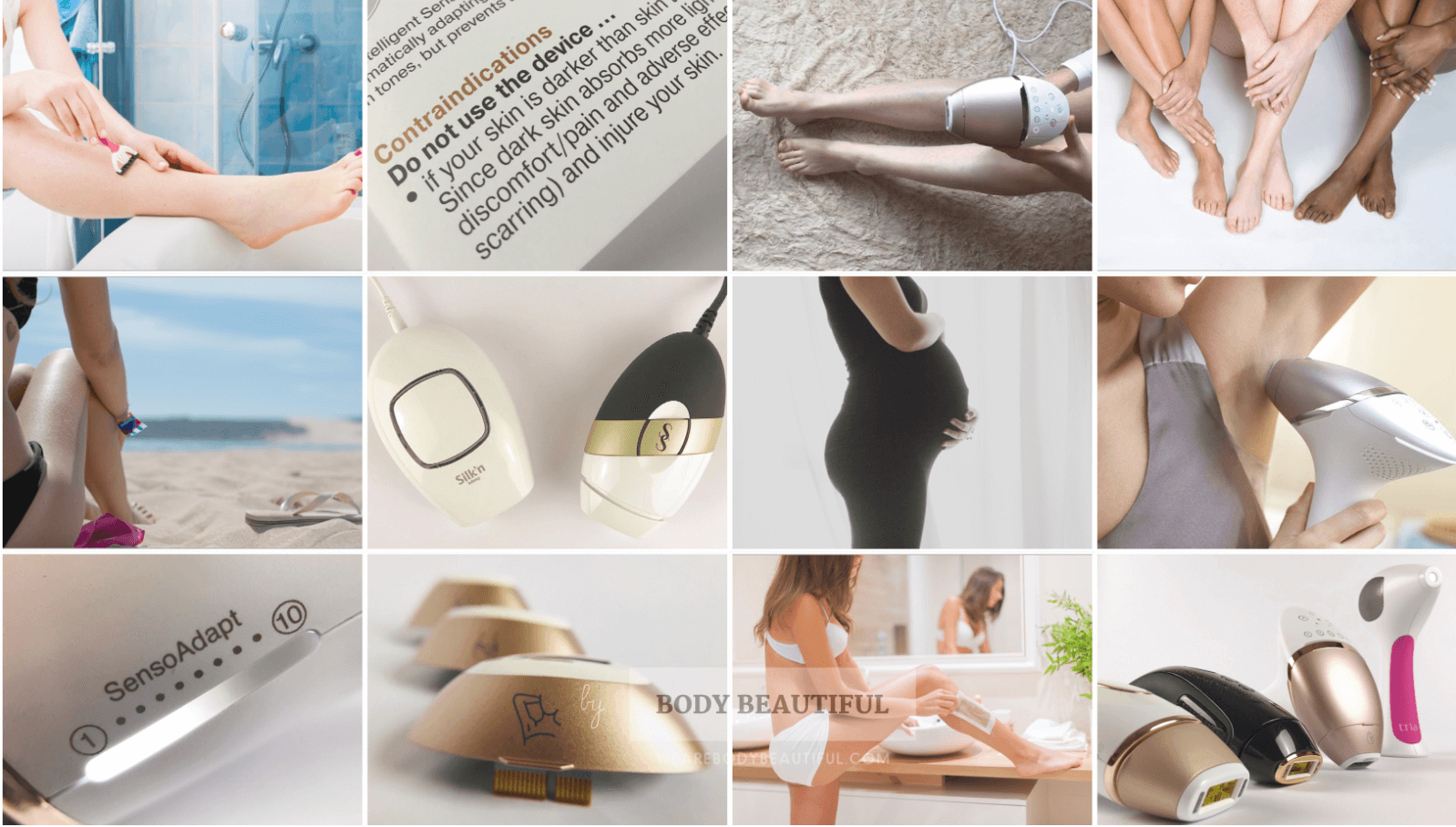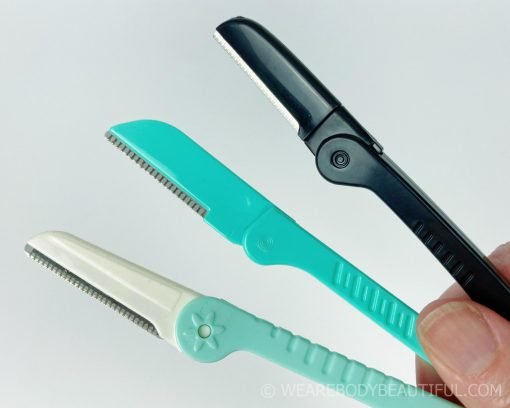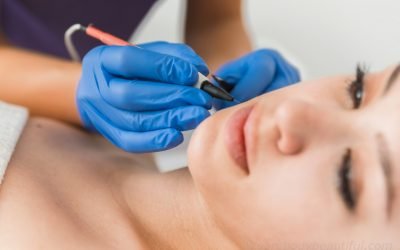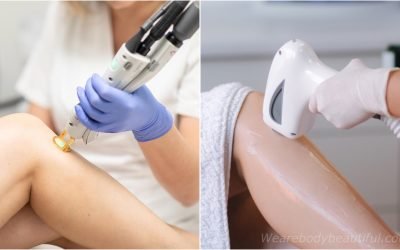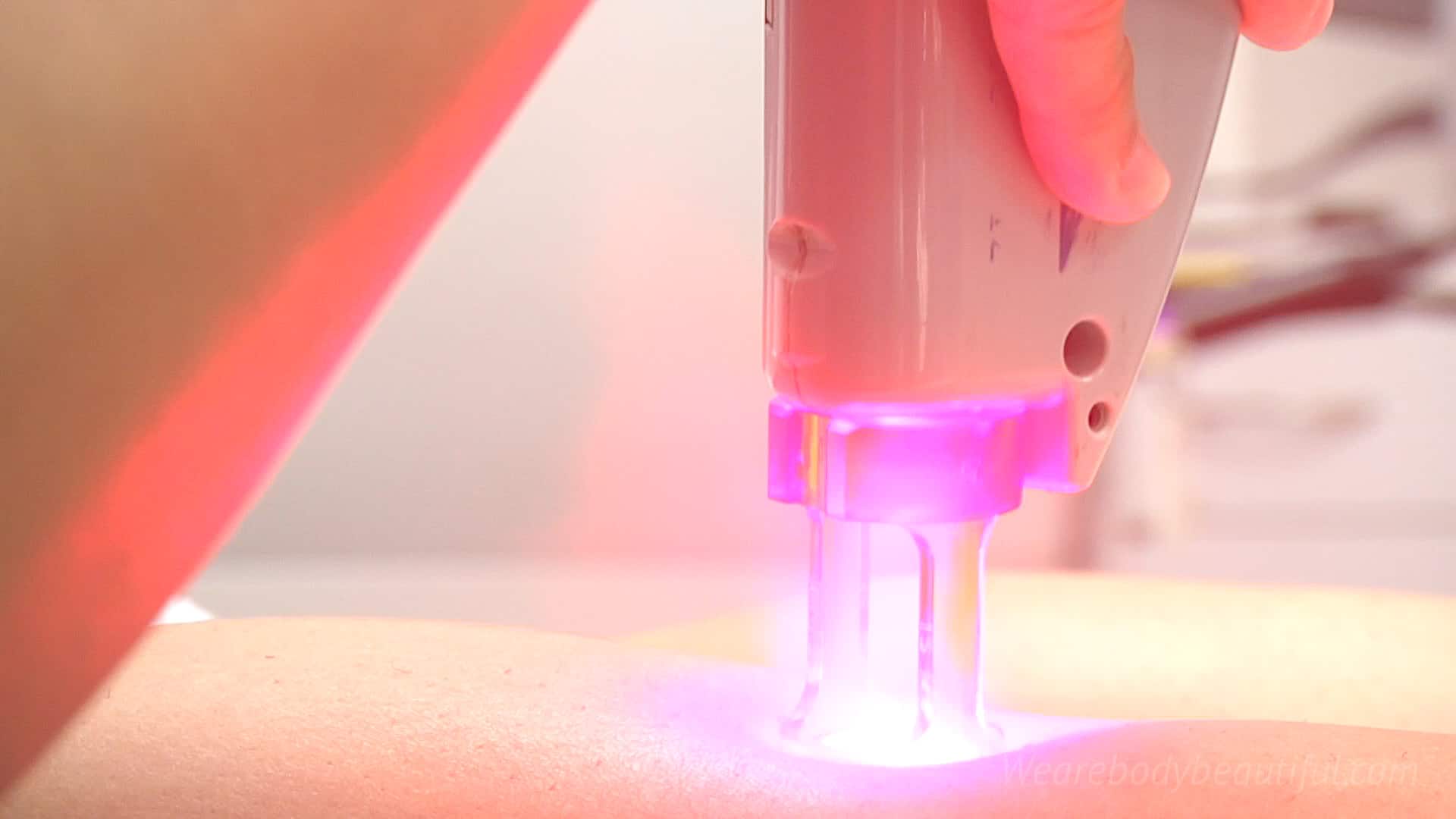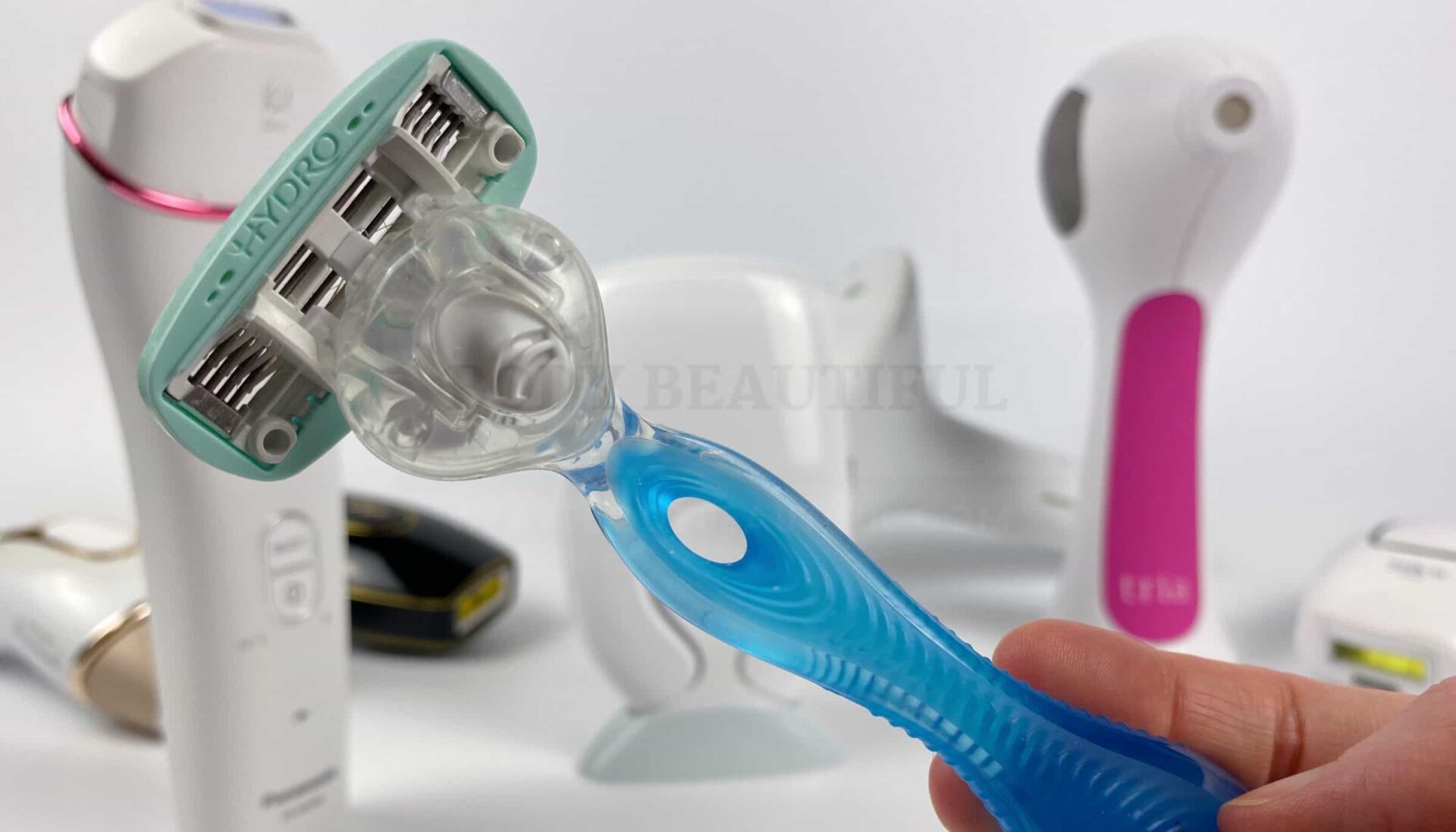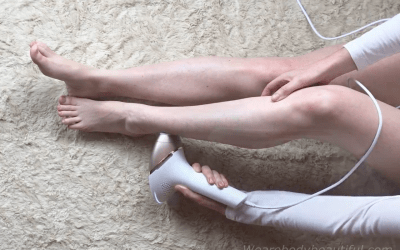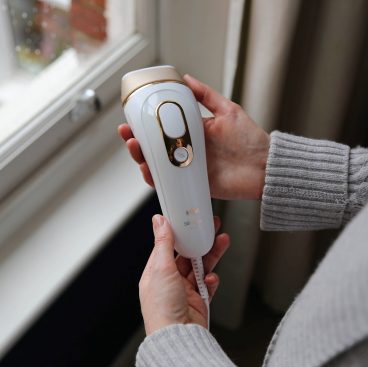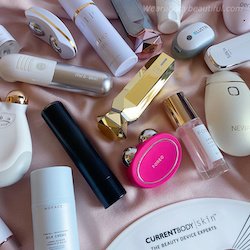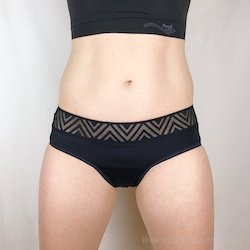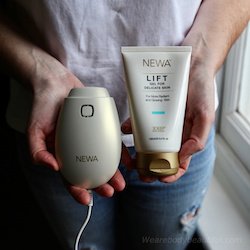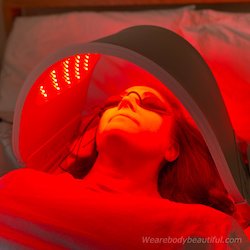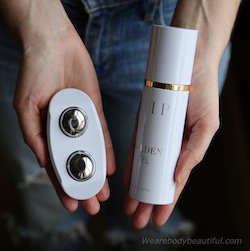At-home laser hair removal gave me stubble-free legs, a tamed bikini line, silky-smooth underarms, and keeps my chinny whiskers under control. Gone are the days of itchy shaving rash, expensive salon waxing, and intense Saturday morning epilator torture sessions. It really does live up to the promise of long-lasting smooth skin.
But, before you start a’zapping, it’s important to understand how it works, possible side effects, and the effort it takes for long-lasting permanent results. That’s why I put this guide together. It details everything you need know before choosing an at-home laser or IPL machine. So, you’re well prepared and know exactly what to expect.
What is laser & IPL hair removal?
Laser and IPL hair removal are very popular cosmetic treatments available in high street beauty salons, medi-spas and clinics. Both use powerful light energy – albeit of very different sorts – to slow and reduce hair growth on your body and face. And there are now many scaled-down versions you can use at home.
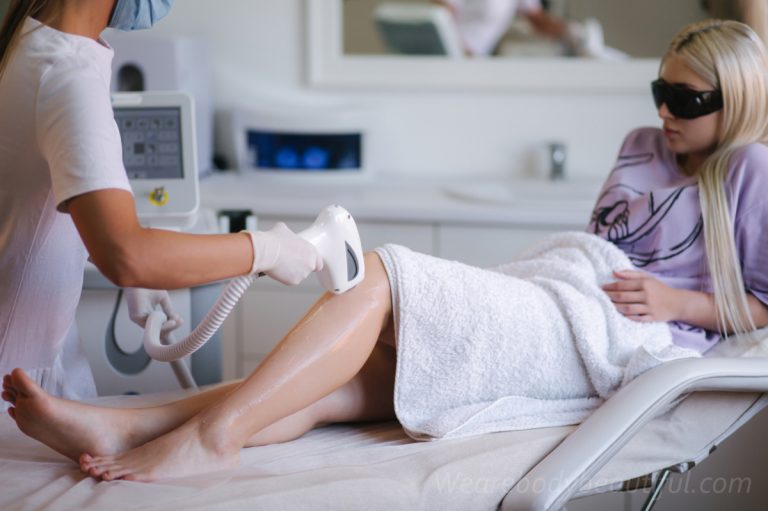
Scientists first discovered the hair zapping properties of lasers and IPL back in the 1970s during unrelated dermatology studies. Demand for long-lasting hair removal is high, so over the next 20 years, manufacturers studied and perfected the technologies. Laser hair removal was first available to the public as a cosmetic procedure, quickly followed by IPL hair removal, both in the late 1990s.
And now it’s BIG business. Recent research reports project significant growth over the next six years.
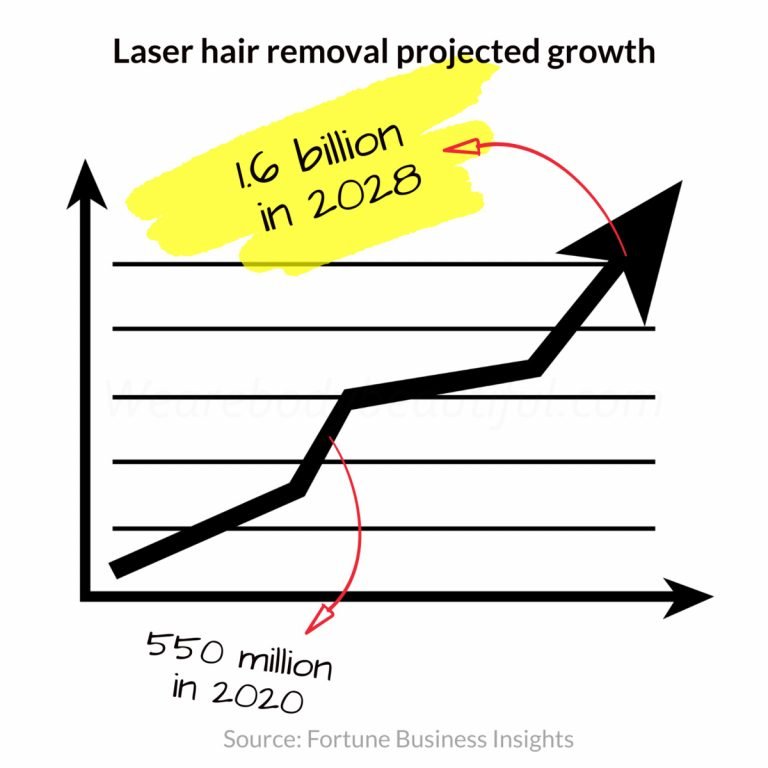
Over the years manufacturers have invested heavily leading to marked improvements in technology, safety, comfort, and results. However, success is largely dependent on the training and skill of your operative. Therefore, it’s vital to choose a qualified and experienced practice for your sessions.
The first at-home devices came to market after 2003. And of course, they’re every bit as popular. Home IPL and laser devices also use powerful light energy to slow and reduce hair growth on your body and face. However, because the devices are portable they’re also considerably smaller. And they give just a fraction of the hair zapping power. That’s to keep them simple and safe for use by you, at-home. But rest-assured they still work.
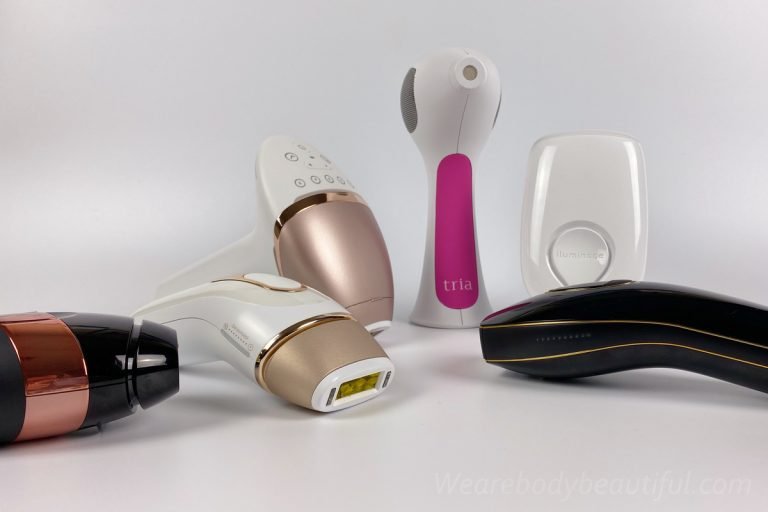
Today’s home devices have sophisticated safety features, comfy and ergonomic designs, and they give super-fast sessions – some in under 30 minutes for your whole body. Lickety-split. Compared to professional sessions, it’s true results do take longer, and you’ll need top-ups too. But they’re considerably cheaper and less time-consuming.
Dig a bit deeper with the posts below, or keep reading to learn how laser and IPL hair removal works.
A BIT MORE ABOUT
What is laser & IPL?
WHAT’S THE DIFFERENCE?
Professional vs at-home
How do laser & IPL hair removal work?
First, I’ll explain what the powerful light energy does. And second, how laser and IPL energy behave in different ways. To start, we need to understand a little about light energy. Here goes…
A bit about light
Light is made of photons and is a small part of the electromagnetic sprectrum. We see light of different wavelengths as colours. And we measure these light energy wavelengths in nanometers (nm). A nanometer is 1 billionth of a metre!
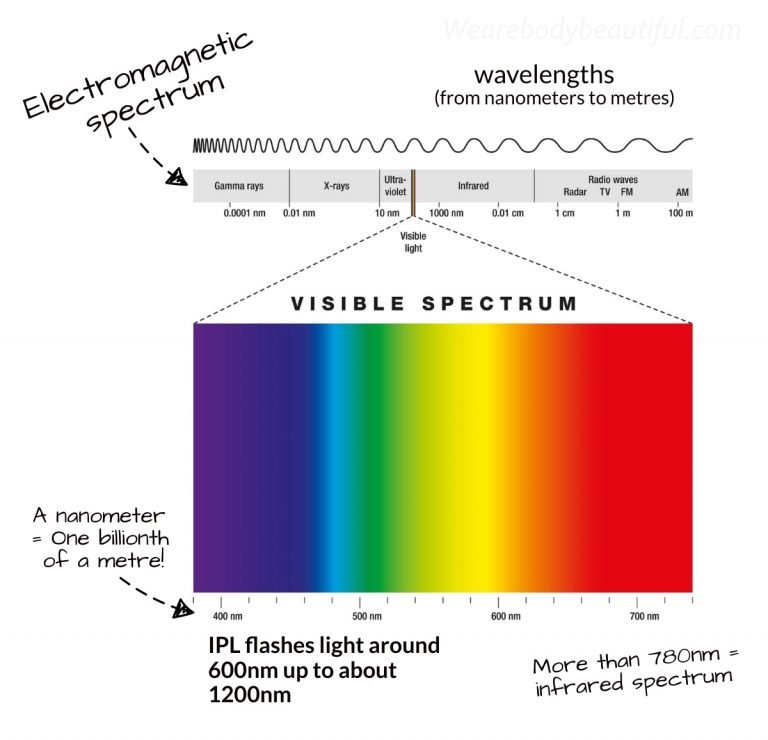
Now, it also happens that different substances in our body absorb the photons in very specific light wavelengths. We call these substances chromophores. Chromophores are the dark pigment in hair (called melanin), oxyhaemoglobin in blood, and water.
For hair removal, we care about the chromophore melanin, in our hair.
chromophore
/ˈkrəʊməfɔː/
Noun CHEMISTRY
- an atom or group whose presence is responsible for the colour of a compound.
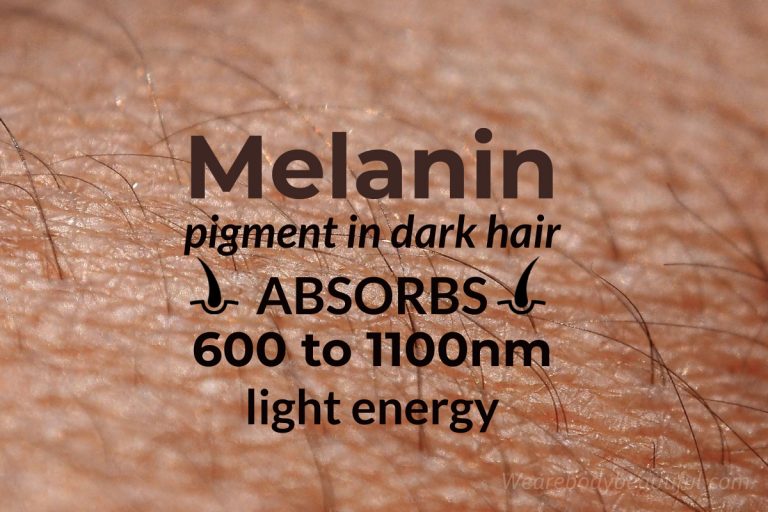
Melanin is a dark pigment and it absorbs wavelengths between 600-1100 nm. Our hair and cells in our hair follicles contain melanin and they absorb the light energy. This converts to heat, which then damages the hair follicle. The hair then shuts down and enters a resting phase. Science calls this process Selective Photothermolysis. The result is you see slower growth, and eventually, many fewer hairs growing; and this is hair reduction.
At-home laser & IPL hair removal also works by Selective Photothermolysis. However, because they’re less powerful devices than professional machines, the effect on your hairs is slower and much more gradual. This rather geeky explainer article 🤓 tells you exactly what happens to your hairs with both professional vs at-home hair removal.
So, that’s how laser and IPL light energy works on your hair. But they do it in slightly different ways because the sources of energy are different. Let’s look at this now.
Different sources of light
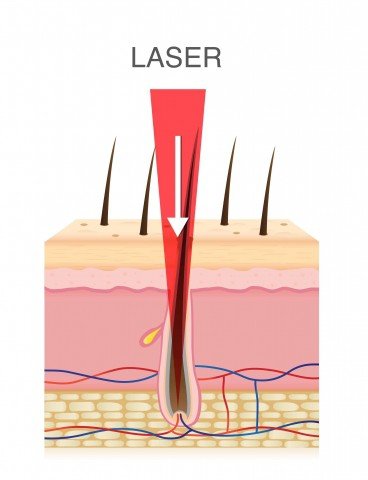
A laser is a monochromatic, coherent and focused beam of light energy.
Monochromatic means it’s of just one wavelength, or colour. Coherent means the wavelengths of the laser light are in phase both in space and time. And the laser focuses all the energy into a small area. So, it has a smaller, targeted treatment area. You can learn in depth how lasers work here.
There are different types of lasers capable of laser hair reduction, because they pulse light energy at the specific wavelengths our melanin absorbs. For example:
- Ruby laser (694nm)
- Alexandrite laser (755nm)
- Diode laser (800nm)
- Neodymium-doped:yttrium aluminium garnet laser (Nd:YAG) (1064nm)
IPL uses a Xenon flashlamp giving bursts of polychromatic diffuse, non-coherent light.
Polychromatic means it’s made of many different wavelengths, or colours, and it can’t focus precisely as a laser can. This means the bulb emits light onto a large surface area. The non-coherent wavelengths randomly fluctuate in phase both in space and time.
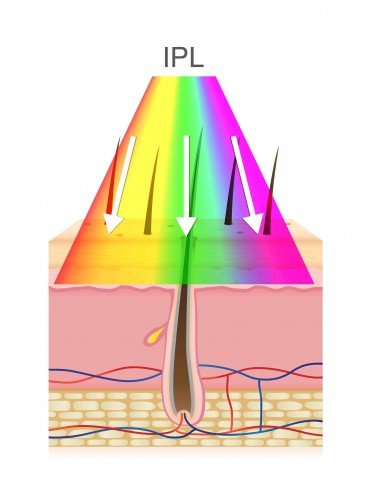
The wavelengths generated by IPL are 500 to 1200 nm. To target just the melanin in our hair, filters exclude the unnecessary light and flash only wavelengths between 600 to 1200 nm.
TIP: IPL can therefore treat several different concerns. Applying different filters on the machines means the light energy also works to treat spider veins and pigmented cells such as sun-spots for facial photo rejuvenation.
You’ll often hear laser practitioners claiming laser is superior to IPL because the laser is coherent and focuses on the hair root. However, in comparison clinical tests, hair reduction results show no significant clinical difference between the results of laser versus IPL.
Dig a little deeper…
THE SCIENCE BIT
What it does to your hairs
WHICH IS BEST?
Laser vs IPL
Can I use it?
Laser and IPL work best on lighter skin tones and dark hair. This section explains why. Plus, which body areas you can use them on, and key reasons which mean it’s NOT safe for you to use.
Let’s start with skin tones…
Safe skin tones
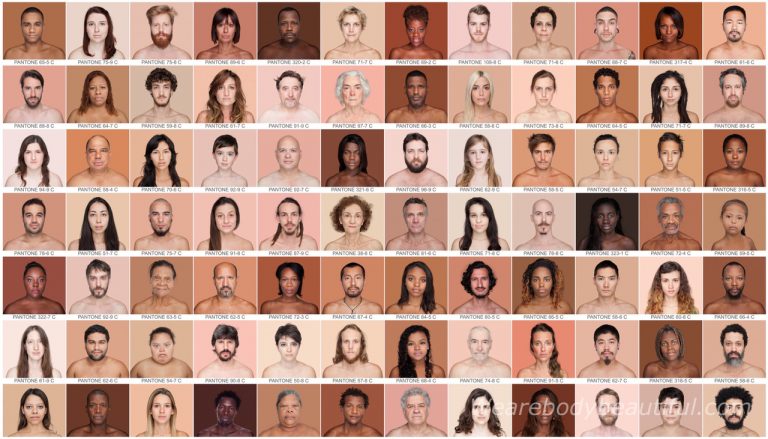
Skin tone is super important because of how the devices work. Remember the laser and IPL light energy heats-up the dark melanin pigment in the hair follicle? Well, there’s also melanin in our skin. There’s just a little melanin in light skin so the light energy leaves it unharmed.
But there’s much more melanin in darker skin. So, the IPL and laser energy heats this up too. Home use devices are much less intense than professional machines, but they can still cause skin damage and pain if you don’t follow the skin tone guidance. Possible skin reactions include temporary or permanent skin darkening or lightening, strong redness, burns and blisters.
So, it’s important to choose a device that’s safe for you. And so you can clearly tell, we use the Fitzpatrick skin tone scale. There are six types (I to VI). Type I is the lightest skin and type VI the darkest, as below.

Look for the skin tone charts on each laser & IPL device review!
All at home devices are safe on tones I to IV. You can also use the higher intensity levels which give longer lasting results! And there are a few options for darker skin tones too. You can learn about IPL for dark skin tones in this round-up.
These are light to medium tones, I to IV:
Type I
Light, pale white skin
Always burns in the sun and never tans
Type II
White, fair skin
Usually burns in the sun and tans with difficulty
Type III
Medium white to olive skin
Sometimes burns mildly in the sun and gradually tans
Type IV
Olive to mid-brown skin
Rarely burns in the sun and easily tans to a moderate brown
And dark tones V & VI
A few home IPL devices filter out the harmful light wavelengths and so they’re safe for dark skin up to type V. And a couple more combine gentle IPL with other technologies and so are safe for the darkest skin type VI too. 👉 Check them out here.
Type V
Brown to dark brown skin
Very rarely burns in the sun and tans very easily
Type VI
Very dark brown to black skin
Never burns in the sun and tans very easily
Best hair colours
The colour of your hair is just as important as your skin tone. If your hair is too fair you’ll see poor results, or even no results at all.
Dark hair with lots of melanin is best. Dark blonde, brown and black hair has a dark type of melanin called eumelanin. Eumelanin absorbs the light energy resulting in effective hair reduction. Yay!
Black
The most eumelanin
(works very well)
Dark brown
Loads of eumelanin
(works very well, too)
Brown
Alotta eumelanin
(Works well)
Dark blonde
Enough eumelanin
(Takes more but still works)
Light blonde, red and grey/white hair don’t have the right type of melanin. Light blonde hair has just a little eumelanin, usually not enough to absorb the light energy. Red hair has a different type of melanin called pheomelanin. Grey and white hair has no melanin at all. All unfortunately won’t absorb the light energy.
Light Blonde
A little eumelanin
(not enough to work)
Red/Ginger
Lots of pheomelanin
(Won’t work)
Gray
No eumelanin
(Won’t work)
White
No eumelanin
(Won’t work)
Despite all his doom and gloom, there are a few possible options from powerful brands offering money back guarantees, or special IPL combined with other energies. Learn more about 👉 IPL on fair hair in this round-up.
Where can you use it?
At-home laser and IPL machines are safe to use on most body areas. But before we look at common areas for women and men, I’d like to start with areas which both women and men MUST NOT use them.
DON’T use them here!
❌ on or around the eyes
❌ in or around the ears
❌ on the testicles, labia, genitals, nipples or anus
❌ over warts, moles or large freckles
❌ on tattoos
Let’s look at common body areas for women first.
For women
For ladies with hursutism and Polycystic Ovary Syndrome (PCOS), at-home IPL and laser devices are life changers. These conditions cause male pattern hair growth, and so at-home laser hair removal devices are discreet and longer-lasting ways to manage embarassing facial and body hair. I have PCOS, and I’m so thankful I found at-home laser hair removal to manage my fast growing chinny hairs! It gave me my confidence back.
You can treat most areas (see exclusions above) from the cheeks down. Choose to treat just a few areas or go for smooth on your entire full body. You may need a helpful assistant for harder to reach areas such as backs of legs, bum and a more precise bikini line. And remember, results are permanent in many cases. So, consider if more extreme looks, such as that Hollywood, will stand the test of time.
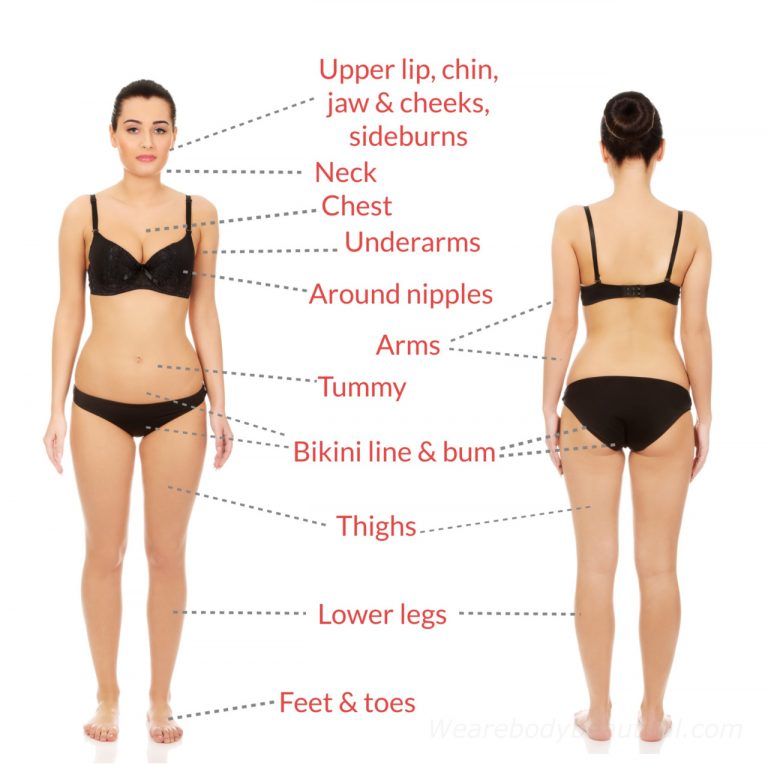
For men
For men, the body areas are the same. But the key difference is that ALL manufacturers warn not to use laser or IPL on men’s beards or face.
IMPORTANT: ALL manufacturers warn not to use laser or IPL devices on men’s beards or face.
It’s a risk to use them there because they’re not clinically tested on male beards. Brands give different wanings, including:
- There’ll be limited results because of the thickness, density and depth of male beard hair
- Using it can cause pain
- It can leave unintended bald patches
- It may have little effect after prolonged use
- Adverse and unsightly reactions are possible – not a good look on your face!
Despite this, I found several Youtubers using IPL or laser on their beards with varying results. Some simply tidy the edges whereas others attempt full beard reduction. This is risky because at-home devices simply aren’t designed to do this. Instead, look at professional laser treatments for men. Reputable clinics can safely treat most body areas, to reduce, style or thin beards and other facial hair.
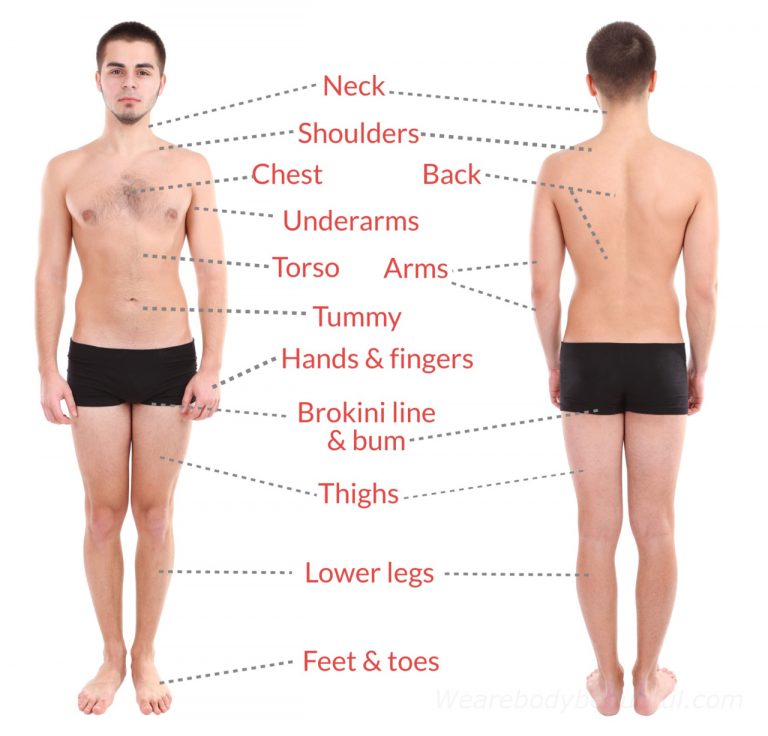
Contraindications: reasons not to use laser and IPL hair removal
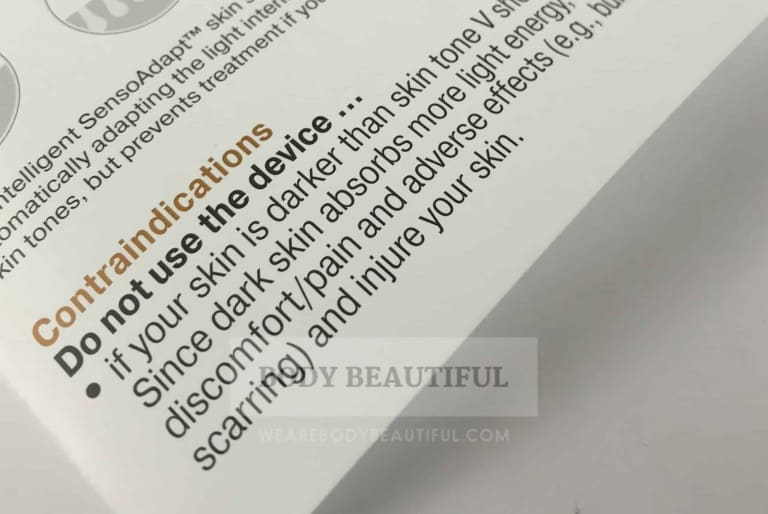
You could be unsuitable to use a home-use laser or IPL device for several reasons. These reasons are called ‘contraindications’ and each brand lists them in their user manual. They include pregnancy, epilepsy and medical conditions or medications making you more sensitive to light.
Here’s a quick summary. However, it’s not an exhaustive list so check with the brand and / or your doctor if you’re unsure. And download and check the brand user manual before you buy a device. Visit the websites or email customer support if you can’t find it.

Key checks ✔️
Before you buy a home use device, check:
- You match the safe skin tones & dark hair colours
- You’re not pregnant, trying to get pregnant or breastfeeding
- You’ve not recently sun tanned or used tanning creams
- You’re an adult. Some brands say over 16 and others over 18

Body areas to avoid ❌
Don’t use the laser or IPL device on or around:
- Nipples, genitals or around the anus
- Ears or around eyes / eyebrows
- Male beard
- Dark brown or black spots such as birthmarks, moles or warts
- Varicose veins
- Damaged skin e.g. sunburns, cuts, open wounds or active infections, cold sores etc
- Tattoos or permanent make-up
- Active implants such as pacemaker, neurostimulator, insulin pump or over silicone implants
- Areas you use long-lasting deodorants

Medical History
Don’t use it if you have a medical history of:
- Conditions such as diabetes, congestive heart disease, history of keloid scars or poor wound healing, epilepsy with flashlight sensitivity, bleeding disorder, immunosuppressive disease including HIV or AIDS
- Sensitivity to light
- History of skin cancer or pre-cancerous lesions
- Radiation therapy or chemotherapy in the past 3 months
- Surgery in treatment area in the last 3 weeks
- Chronic skin disease e.g. psoriasis or vitiligo
- A skin peel (within different time frames given)

Medications
Don’t use if you’re taking or have recently taken these medications:
- Painkillers, which reduce sensitivity to heat
- Immunosuppressive medications
- Anticoagulation medications
- Medications which make you sensitive to light e.g. Retin A, isotretinoin Accutane or other topical retinoids
Always check your medication instruction leaflet to see if photosensitivity is a listed side effect.
Is laser hair removal safe?
At-home laser and IPL hair removal is typically safe and well tolerated when you follow the contraindications (see above). So, in this section we’ll look more closely at the safety credentials, important device safety features, guidance around sun exposure, and the possible side effects too.
Safety tests & features
The last 30 years of research and product development mean we have refined light and cooling technology, and fine-tuned procedures for better laser hair removal results, patient comfort and safety. There are hundreds of positive clinical reports publicly available. Powerful, professional machines are considered safe and effective if administered by a trained and skilled operative. And you can choose professional, doctor-led dermatology clinics to perform your procedure too.
A FEW MYTHS…
IPL and laser hair removal causes cancer?
❌ Nope. One scientific review concludes from the evidence of over 25 years of laser and IPL there’s no link to cancer.
IPL filters out any light in the UV range, so there’s no exposure to that. And the type of light energy in both IPL and laser hair removal can’t cause cancer in your skin or in any organ in your body. The energy reaches your follicles only and not any deeper. Plus, it’s not capable of causing any damage or mutation to your cells.
IPL & Laser hair removal causes infertility?
❌ Again, untrue. There’s no data to support this. The IPL and laser simply don’t reach deep enough to hit any internal organs.
DIY devices are considerably less powerful, and with simplified controls so they’re easy to use at-home. They have clear, safe skin tone labelling, and a selection of intensity levels to match the safe skin tone range. The latest models also have super safety features, such as:
✔️ IPL devices have inbuilt UV filters to protect your skin
✔️ Skin contact sensors prevent accidental flashes into open space and so protect your eyes (so there’s no need for goggles or glasses)
✔️ A skin tone sensor which detects skin that’s too dark and won’t flash
✔️ Clever skin tone sensors to match the intensity to your skin tone, some before every single flash
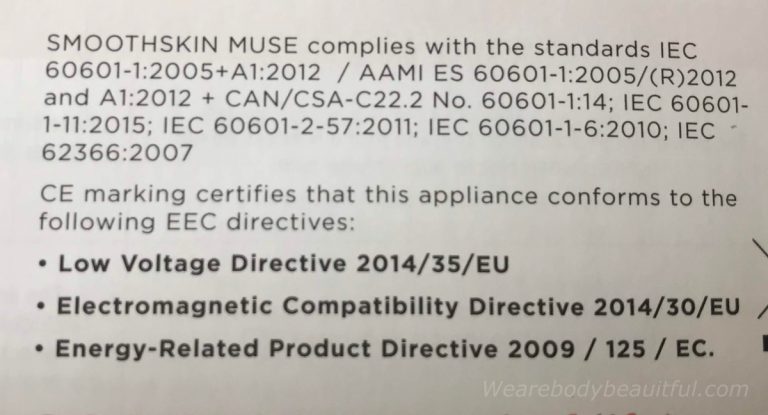
All of the devices I recommend are clinically proven safe for home use. They’ve also attained safety and quality standards from the IEC (International Electrotechnical Commission), and they meet the EEC (European Economic Community) directives to show the CE Marking. Most are FDA-cleared for sale in the US. And they’re from expert brands who develop and enhance their own technology and safety. They are never cheap, mass-produced and rebranded white-label devices.
But it’s still very important you follow the skin tone guidance, contraindications and tanning guidance outlined in the user manuals. Let’s look at tanning and sun exposure next.
Tanning guidance

IPL / laser hair removal and tanning don’t mix for two big reasons.
- Safety: The combination increases your risk of skin reactions
- Effect: Tanning darkens your skin so you’ll need to user a lower power intensity level. The higher levels are most effective.
Therefore, when using at home devices, you must be mindful if you sunbathe regularly, or spend a lot of time outdoors.
To protect your skin and keep you safe, the device manufacturers provide warnings and guidelines around fake tanning, sunbathing and sun exposure. Check them in the user manuals before you buy.
So, what are the sun exposure guidelines?
Before your treatments
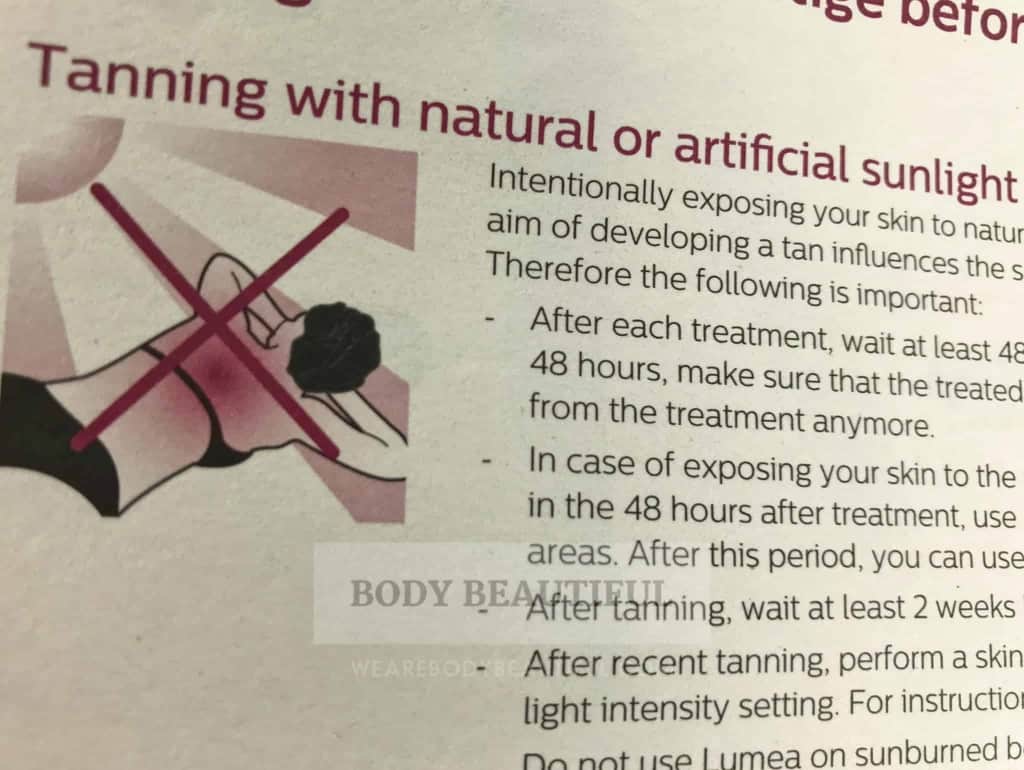
Manufacturer guidelines vary for how long you must avoid the sun before your treatments. Some say a cautious 4 weeks, a few a more manageable 7 days, and one a short 48 hours.
All advise you must perform a new patch test if you’ve had recent sun exposure. This checks your skin’s sensitivity to see if you need a lower than usual intensity.
Here’s why: Whether you tan easily or slowly, natural and artificial sunlight increases the melanin in everyone’s skin. If you use laser or IPL after sunbathing or sun exposure, you’ve got a high risk of reactions and damage to your skin. Damage such as burns, blisters and temporary and permanent skin darkening (hyperpigmentation) or lightening (hypopigmentation) or scarring.
After your treatments
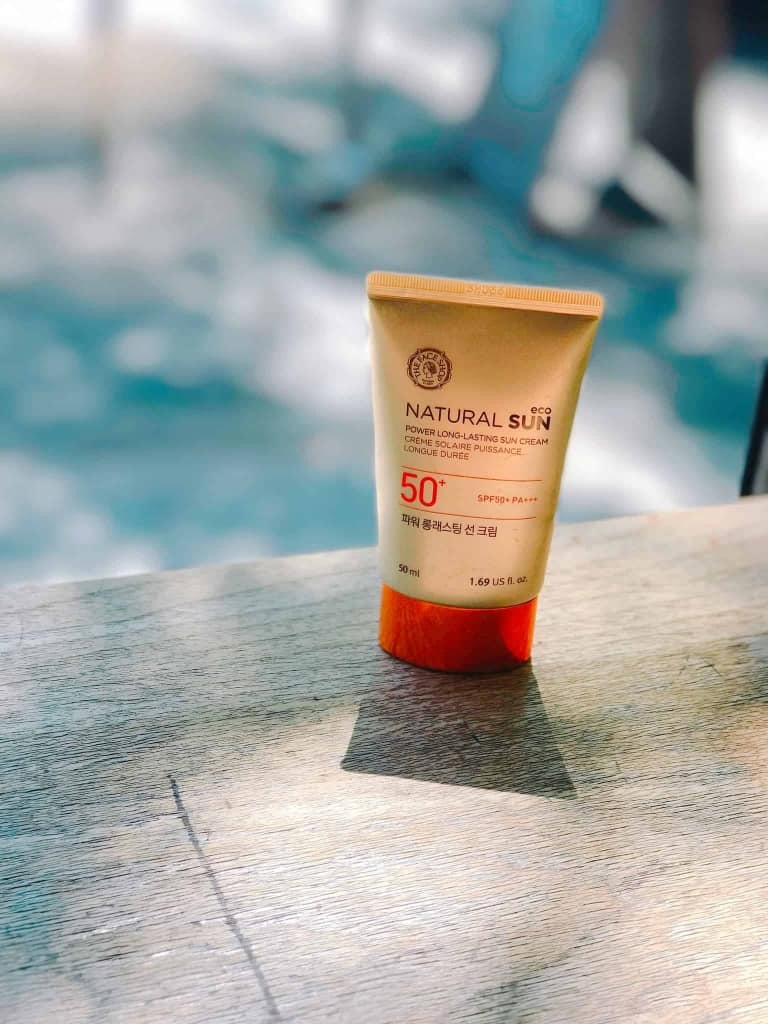
Post-treatment sun exposure guidelines vary too. The most cautious says avoid the sun altogether for 2 weeks after your treatments. Another recommends at least 7 days. And just one suggests 48 hours. All say to use a minimum SPF 30+ in the sun for around 2 weeks after your treatment.
Here’s why: laser and IPL makes your skin extra sensitive so it’s at more risk than usual from sunburn and side effects after your treatments.
Tanning with creams
Manufacturers say to wait for the artificial tan to disappear completely before treating your skin.
Should you avoid tanning altogether?
Yes. The majority of guidelines mean it’s safer and more effective to complete the start-up stage before you start working on your tan (both natural or artificial).
Without a tan you:
- Can use the highest energy intensity level suitable for your skin type, and so get best results
- Don’t increase the risk of sunburn after a treatment
- Don’t increase the risk of post-treatment skin reactions
- Get the best results from your treatment regimen
TIP: Complete your treatments in Autumn or Winter months, or if you can’t avoid the sun cover up and use minimum SPF30 sun lotions. It’s best to stop using fake tan lotions too.
Once you’ve completed your start-up phase, it’s easier to plan occasional top-up treatments safely around sun exposure and tanning.
For some, these guidelines are impractical or the need to tan outweighs the need to banish those hairy areas! You must decide if it’s right for you. Or you risk your machine gathering dust in the bottom of a draw.
Side effects of home laser & IPL hair removal
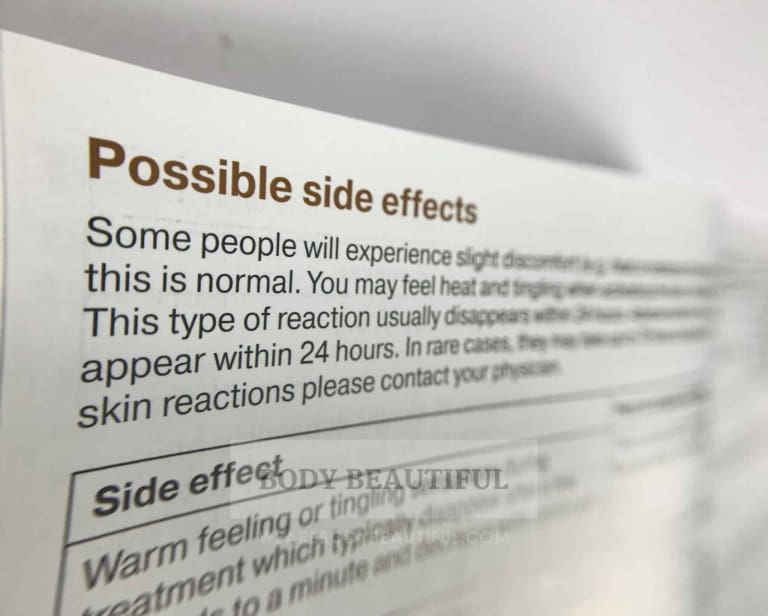
There are some very rare side effects with home use laser & IPL devices.
These generally occur when the intensity is too high for your skin. You should wait until your skin heals and returns to normal before doing another session. And at a lower intensity.
Below is a list of the possible but rare side effects. If they don’t fade within the times detailed below, go see a doctor.
- Burns, excessive redness and swelling around your hair follicles, should disappear within 3 days
- Lighter or darker skin patches, should disappear within 2 weeks
- Epidermal heating is a sharply defined brownish area that’s NOT dry, and it’s most common with darker skin tones. It should disappear within 1 week
- Blistering, small bubbles on the surface of the skin, which should disappear within 1 month
- Skin infection can occur, especially after a burn or skin irritation
- Scarring, usually following a burn that takes longer than 1 month to heal
- Folliculitis is swelling and pustules around your hair follicles caused by bacteria in damaged skin. Go see your doctor immediately for treatment
The Tria 4X laser user manual also notes another slightly alarming side effect; it’s possible to see increased hair growth after your first session! It should stop. However, if it continues after several sessions go see your doctor.
Staying safe checklist
Your chosen device is safe to use with your skin tone.
For the darkest skin, checkout this dedicated at-home IPL roundup.
None of the contraindications apply to you.
If you’re in doubt, ask your doctor, or get in touch with the brand support team to answer any questions you have.
Look for helpful safety features.
If you’re scared of making a mistake, you can choose a device with a clever skin tone sensor. It takes the guess work out of which intensity to use. Try the Prestige, Pure or Braun IPLs.
And if you’re worried the flashes might hurt, try the Silk’n Infinity. The flashes are soft and gentle. But it still works very well indeed.
Follow the sun exposure guidelines.
If you don’t there’s a much higher risk of nasty skin reactions and side effects.
How to prepare
It’s important you read the user manual and do a skin sensitivity test patch before your first session. For each subsequent sessions, it’s best to shave your hairs. Learn about all this, in this section, plus alternatives to shaving and some helpful tips to get a comfy and productive set-up.
Read the user manual
It’s very important you read the user manual thoroughly.
TIP: 📖 Read it before you even buy a device. Head over to the brand website – most have a downloadable copy. If they don’t, email customer support and ask for the latest version.
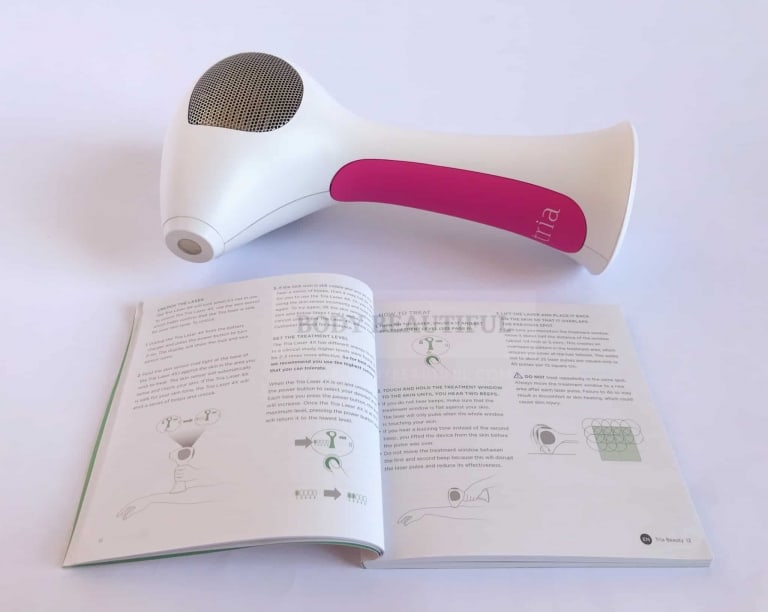
Reading it helps you understand how to use the device for best results, lists the contraindications or reasons you’re not suitable to use it, warnings and precautions, explains the treatment schedule, what to expect and gives a troubleshooting guide.
N.B. Some devices come with a shorter quick start guide. This is a handy reminder for your subsequent treatments. It’s not a substitute for the full user manual which has much more comprehensive information.
Do a patch test
With most devices you must do a patch test. Shave a spot in your treatment area and zap it according to the instructions in the user manual.
This confirms it’s safe for your skin, and you won’t have any side effects. With some devices you must test a few different intensity levels to find your ideal one. With other devices they choose the best intensity level for you. Wait the recommended time (usually 24 hours) and check your skin. If you’ve still any reaction, you should either test again at a lower intensity or talk to your doctor.
If you haven’t used the device in a while, especially after Summer if you’ve tanned, it’s wise to do another patch test.
For best results shave
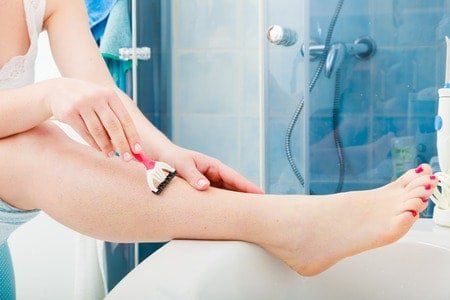
Shaving immediately before each session gives you your best results from home IPL and laser.
TIP: Hair conditioner works brilliantly on legs, underarms, and bikini line instead of expensive shaving gels!
Hang on though. Do you have to shave your face?
Shaving your face is just too darn masculine! Yup. I agree. Now, most brands suggest instead you trim your facial hair with scissors. But I think a dermaplaning tool is a much better solution.
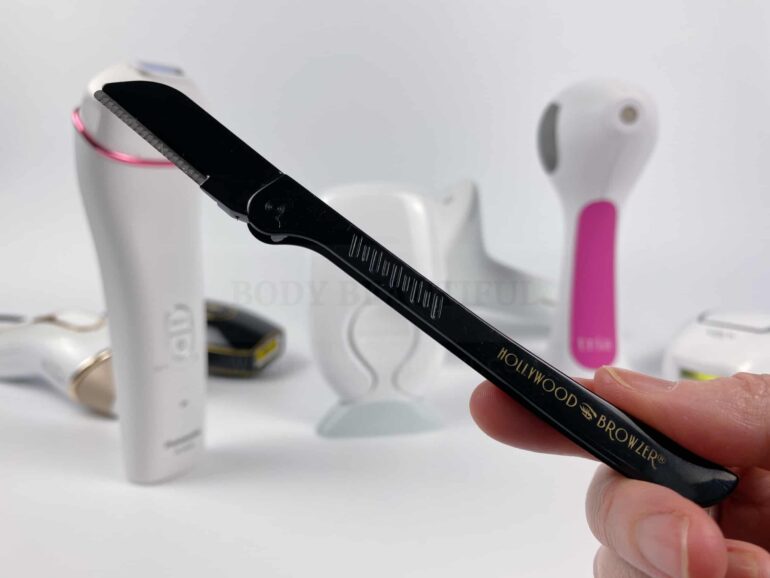
Use them on your upper lip, chin, jawline, sideburns, cheeks and even for an eyebrow tidy-up! Simply stroke them along your dry skin at a 45°angle. The sharp, safe blade removes thick hairs, soft peach-fuzz and exfoliates the dead, dry outer layer of skin. You don’t need shaving foam, gel, oil or water. And your hairs won’t grow back thicker or darker either.
Before each session, make sure you’ve had a close shave and there’s no hair left on the skin surface. If there is, it stings and burns with each flash! Also, ❌ don’t apply any moisturisers or deodorant to your skin as this could cause unwanted reactions with the light energy!
Shave before every subsequent treatment. And you can also shave in between sessions as you need. It becomes much faster and easier as your hairs soften, so stubble isn’t a concern for long. Then bald patches appear until eventually there’s no hair to shave away! Before your sessions or top-ups, simply check your skin for any stray hairs and shave/dermaplane them if you need to.
TIP: DON’T use hair removal creams because they may cause skin reactions with the IPL.
A few brands say you can wax, epilate or pluck your hairs before a session. However, the IPL and laser won’t be quite as effective versus shaving.
Learn more about dermaplaning, and shaving vs waxing/plucking, and you can check out dermaplaning tool links below.
Dermaplaning tool deals
Links with 🍃 have a handle made from biodegradable materials.
🌎 International
🇺🇸 United States
🇨🇦 Canada
Get a comfy set up
Next, choose a comfortable spot to do your treatment. Depending on which body areas you’re treating, privacy is a good idea too.
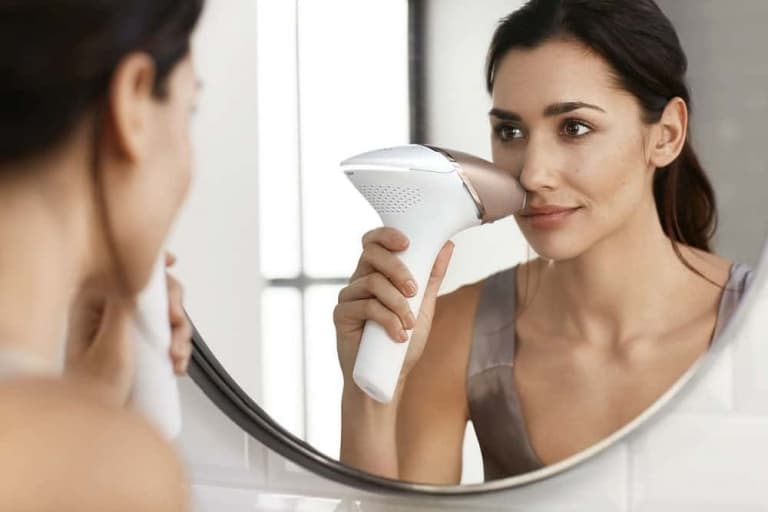
You may want to set up in the living room and watch TV. Or in your bedroom. Here are a few tips to get started.
- In front of a mirror: A full-length mirror is very helpful for a thorough bikini line, underarms and backs of legs
- A mains extension cable: Most devices have a long power cord, but maybe not long enough if you want to sit on your bed. So, an extension cable from the mains gives you more.
- Find privacy: Zapping your bikini line or bum lacks elegance and it’s not something you’ll want to share with housemates, kids, window cleaner etc. Try to find privacy in your bedroom or bathroom.
- Choose the right time: It takes time and concentration to get good results. So, stop any interruptions. Choose a time when kids are tucked up in bed.
Coming up, what it feels like and possible skin reactions. Then, what hair reduction results to expect.
What does it feel like?
Laser and IPL sessions are a little different. So let’s cover IPL first.
What do IPL sessions feel like?
You’ll hear the cooling fan whirring and a soft ‘pop’ with each IPL flash.
The IPL flashes are bright, but harmless to your eyes. You don’t need to buy specialist goggles or glasses. Use it in a well let room so the flashes don’t seem so intense. Some people find it gets tiresome after a while and wear sunglasses to ease the irritation.

You may smell some singed hair too.
The flashes mostly feel warm against your skin. But some areas, like ankles, thighs, bikini line and underarms can smart more because they’re more sensitive. Most brands liken this sensation to an elastic band snapping against the skin. It’s instantaneous, uncomfortable but bearable.
You may also feel increased heat on your bikini line and underarms where your hair is generally thicker and denser. From the online feedback, users with darker skin tones report it hurts most frequently. It can depend on your hair density and skin sensitivity. In any of these cases, drop the intensity level a notch or two if it’s too much.
Try starting with your face and more sensitive areas when the flash window area is cool. It also takes a bit of concentration so you don’t miss any areas.
IMPORTANT: You can feel pain if your skin isn’t hair free, if the light’s too intense for your skin, if you flash the same area more than once, or if you flash an open wound, infection, tattoo etc.
What does laser feel like?
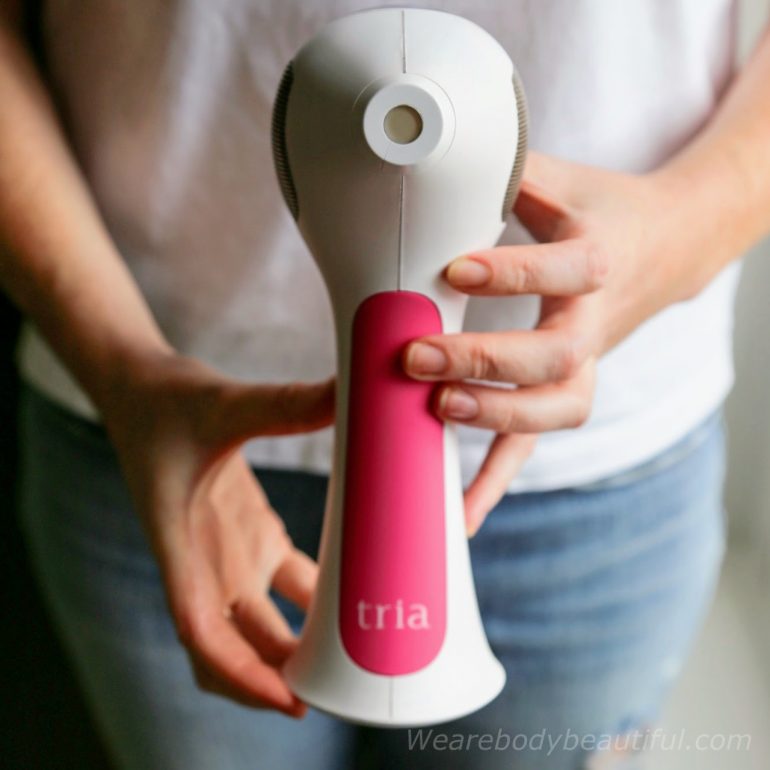
There’s one home-use Diode laser hair remover.
You’ll hear the whirring cooling fan. It communicates with a series of beeps and buzzes. Beeps confirm when something is done and a buzz means bad skin contact and you need to zap that bit again.
You may smell burning hair too.
You won’t see any flashes or light from the Tria 4X at all.
It takes lots of concentration. That’s because the zap area is so small and you need to get just the right amount of overlap. You can work in roughly 30 minutes sessions until the battery charge runs out.
Based on the negative and positive user feedback there are more reports of pain with the Tria then with other IPL devices.
Again, Tria use the elastic band-snapping analogy. For some this is true, but for others it’s a much more intense, hot and sharp sensation.
The Tria laser light is the most powerful home-use device. All intensity levels are safe for Fitzpatrick types I to IV. A clinical study suggests the higher levels are 2 to 3 times better than the lower ones. And on the highest level the power is 20 joules per cm2.
This energy reaches deep down to the hair follicle and the melanin in your hair absorbs it. This causes more heat than with IPL. Therefore, there’s more damage to the hair follicle, but for some people it’s accompanied by pain. It depends on the individual.
Some users try the Tria Smooth start gel, lidocaine gel or just an ice pack to numb their skin. You can also reduce the intensity level. After a few sessions painful sensations mostly reduce too.
Related: the best home IPL device vs the Tria 4X laser – how do they compare?
So, what should you expect after your treatments?
Common skin reactions
Skin redness is a common reaction to IPL and laser. Your skin may also feel a bit hot and tingly. It could feel dry and itch a bit too. That’s likely due to the combination of shaving and light.
It’s all normal and should wear off within 24 hours. You can cover it with a cool face cloth or ice pack. Cooling water sprays are good too, Aloe Vera gel or a non-scented moisturiser.
If you have no reaction at all, you can apply your usual cosmetics, moisturisers and deodorants. If your skin becomes irritated afterwards, wash off any products you applied.
After your treatment, avoid things that could irritate the skin you’ve flashed. For example, using hot tubs and saunas, wearing tight-fitting clothing, using bleaching creams and perfumed or exfoliation products.
Avoid the sun and wear an SPF 30+ on areas exposed for prolonged periods. If you don’t you risk experiencing some of the rare home IPL and laser side effects.
Treatment schedules & results
First up, let’s see what the recommended treatment schedules look like, then what results most people see and when.
Treatment schedule
Each brand recommends a start-up phase. This schedule is usually the same regimen followed in the clinical tests.
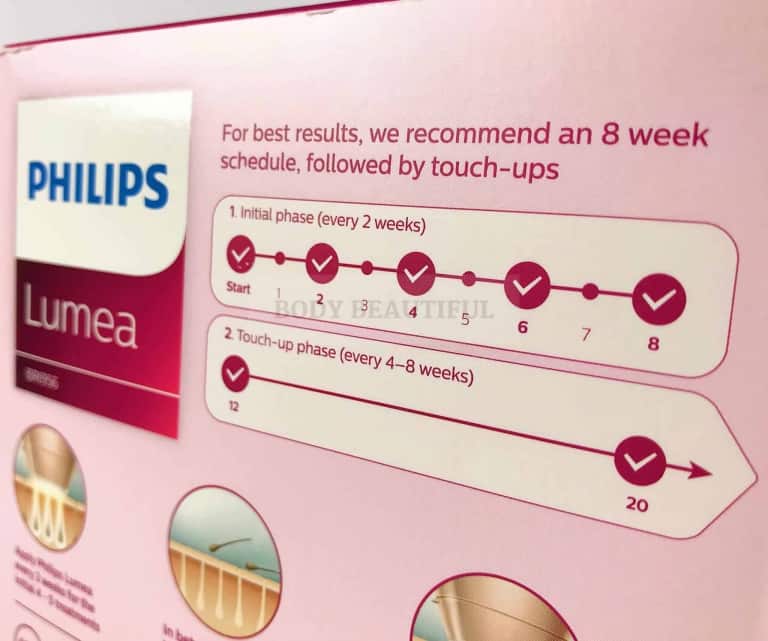
The start-up phases are between 4 to 12 sessions. Some you must do weekly and others every 2 weeks. You keep up with these regular sessions until your skin is smooth. Then you do less regular top-up sessions to stay smooth. Most need these at 1- or 2-month intervals.
Here’s a quick summary by brand:
| Brand | Start-up sessions | Frequency | Top-ups |
|---|---|---|---|
| Philips (all models) | 4 or 5 | Every 2 weeks | Every 4 to 8 weeks |
| Tria 4X laser | Up to 8 | Every 2 weeks | As needed |
| Smoothskin Pure | Up to 12 | Weekly | Every 4 to 8 weeks |
| Smoothskin Bare+ | Up to 12 | Weekly | Every 2 or 4 weeks |
| Braun Silk Expert Pro 5 IPL | Up to 12 | Weekly | Every 4 to 8 weeks |
| Braun Silk Expert Pro 3 IPL | Up to 12 | Weekly | Every 4 to 8 weeks |
| Silk’n Infinity | 1 to 4 5 to 7 |
Every 2 weeks Every 4 weeks |
As needed |
| Remington | 1 to 3 4 up to 12 |
Every 2 weeks Weekly |
As needed |
| Panasonic (face) | 10 | Weekly | As needed |
Top-ups are just as important
So, with all brands there’s similar upfront commitment and investment in effort and time. But what’s important (and often not made clear) is the top-ups are very important too.
A recent long-term study of home IPL devices found that the top-up sessions continue to work on your hair follicles. The effect deepens so the more you do the longer your hair-free results last.
The study showed that if you stop at 4 sessions hair grows back. But if you continue for 1 year with less frequent sessions (every 6 weeks) you’ll achieve high hair reduction lasting for at least 1 year after stopping the sessions.
New hair growth is still possible. That’s because dormant hair follicles can activate and grow new hair. So, hang onto your razor! You can shave and do just very occasional top-ups as you see any new growth.
Related: Is laser hair removal permanent?
These are the typical results which most people experience. However, results do vary by individual and ALL brands note this on their websites and in the user manuals. So, what does this mean?
Results vary
There are a few things affecting your hair reduction results. They are:
- Your skin and hair colour combination (results generally take longer on light hair and / or dark skin)
- Hair thickness
- Your genetics
- Hormones, and conditions like hirsutism (excessive hair growth) and PCOS
- How thoroughly you cover your skin
- The number of sessions / top-ups completed
‘Varied results’ mean you may get a lower hair reduction (amount and thickness of hair) than promoted by the home brands. The results may not last as long either so you could need more regular sessions to maintain your results.
A small number of online feedback from all devices matches this too. Whilst a few are very disappointed they don’t see the advertised results, many others are still happy. That’s because they’re able to maintain longer-lasting results with much less time and effort than before. A regular session every few weeks sure beats painful daily plucking or shaving, or the expense of waxing sessions. For them the results still feel life-changing.
TIP: From online reviews, several people with PCOS use home IPL and laser as an affordable way to manage persistent and visible facial hair. It proves much more effective than plucking and waxing, and it gives them their confidence back.
So, what are other results from user reviews of home IPL and laser hair removal machines?
User feedback hair reduction results
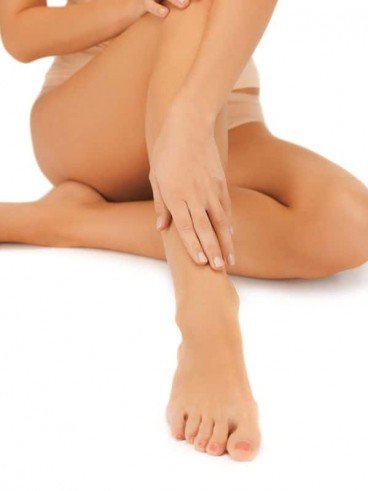
From the user reviews, there’s a small number who, despite being excellent candidates, don’t get the results they want. Others are disappointed because they stop using it and the hair eventually grows back.
But most experience results that match the start-up phases. It goes like this:
- After 1 or 2 sessions you’ll still see hair growth. And hair doesn’t fall out immediately. Shave before your next session.
- After 2 to 4 sessions you should see less hair and smooth patches. Your hair is also finer and lighter, and easier to shave.
- After 3 to 6 sessions you should have large bald spots, very fine and light regrowth or even be totally smooth! You may not need to shave between sessions.
- After that continue as directed by the user manual either to complete the full regimen or start your maintenance phase with top-ups every 4 to 8 weeks.
Some users experience very fast results, whereas others needed 2 or 3 times as long. It varies by individual. So, if you don’t see results within a few goes, don’t give up! Stick at it and give it more time.
Totally smooth?
It’s also important to note that some never get to totally smooth. What they get is very slow, fine and light regrowth. They can go from shaving daily to every week or month.
Some also need top-up sessions more frequently than every 4 weeks. However, they’re happy because it’s much easier to shave and they do it so much less frequently. Overall, they spend much less time and effort to feel silky smooth.
Some long-term reviews share the longer they’ve done their top-ups the less frequently they need them. Some only do a couple every year, or as they see new hairs growing. This is my experience also, and shows results are very long-lasting after several frequent top-ups.
Other reported effects
Other happy effects are no more shaving rash or bumps because hair’s so much softer and finer. Skin feels soft, smooth and healthy.
The black dots associated with hair growth disappear. And pores seem to shrink too.
No more scratchy armpit or bikini line stubble either. And loads love that itchy and unsightly ingrown hairs quickly disappear!
I love being able to wear what I want, when I want. Shorts, skirt, summer dresses, bikini. I’m ready for it all.
How to choose an at-home machine?
So, now you know all there is to know about home laser hair removal! If this all sounds good you’ll be ready to go for it! But there are so many home devices to choose from. How do you find your perfect match?
If only there was a quick way to learn which machines are best…
*clears throat*
Just choose from the tried-and-tested round-up guides below. For every device in each round-up you’ll see which body areas its best suited to, the price range, any money back guarantees, the lamp lifetime, ease of use, effort and results, and a pros and cons summary. See you there…

